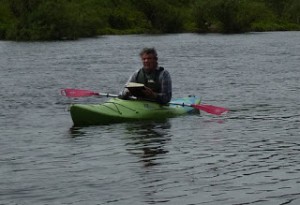As usual, life is so full of exciting activities that it’s hard to find time to blog, especially when I’d rather be communing with nature than with a computer. What a tremendous autumn it’s been – the combination of lots of sunshine and amazing autumnal colours has really provided some stunning images for the landscape artist.
My autumn course in Mid-Wales benefited from the colours and sunshine so much that we were able to paint out of doors in October, even quite high up in the Brecon Beacons. Here the group is painting the main peaks with a stream leading nicely into the focal point. There is still a lot of colour around, so you may well find it rewarding to get out and capture those scenes. A few dabs of masking fluid can be very effective for rendering those bright-coloured individual leaves that still hang around.
Don’t forget though, that a drop of rain can liven things up by creating puddles. These can form really useful features in a foreground, and can be introduced into a painting quite easily. They really come alive if you stand on the opposite side of the puddle to the sun, as the backlighting can create extremely bright and contrasting tones as you can see in the photograph on the right. It gets even better if you can get some of those autumn colours to reflect in the puddle, See how the light part of the puddle stands out against the darker leaves on the right-hand side, and the dark water stands out against the glistening wet surface of the path at other points. We can learn so much simply by observation like this, but it’s even better if you can manage a sketch and a photograph of the scene, as it will really drive the effect home.
It was great to meet so many enthusiastic folk at my seminar in Great Bookham last week, and the response was really heart-warming. Thanks to you all who came along for the event. My exhibition across the road in the Lincoln Joyce Fine Art gallery continues until November 14th, so there is still plenty of time to pay a visit. http://www.lincolnjoyce.com/ or Tel. 01372 458481






